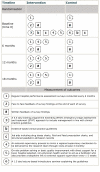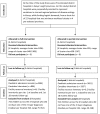A multifaceted intervention to implement guidelines and improve admission paediatric care in Kenyan district hospitals: a cluster randomised trial
- PMID: 21483712
- PMCID: PMC3071366
- DOI: 10.1371/journal.pmed.1001018
A multifaceted intervention to implement guidelines and improve admission paediatric care in Kenyan district hospitals: a cluster randomised trial
Abstract
Background: In developing countries referral of severely ill children from primary care to district hospitals is common, but hospital care is often of poor quality. However, strategies to change multiple paediatric care practices in rural hospitals have rarely been evaluated.
Methods and findings: This cluster randomized trial was conducted in eight rural Kenyan district hospitals, four of which were randomly assigned to a full intervention aimed at improving quality of clinical care (evidence-based guidelines, training, job aides, local facilitation, supervision, and face-to-face feedback; n = 4) and the remaining four to control intervention (guidelines, didactic training, job aides, and written feedback; n = 4). Prespecified structure, process, and outcome indicators were measured at baseline and during three and five 6-monthly surveys in control and intervention hospitals, respectively. Primary outcomes were process of care measures, assessed at 18 months postbaseline. In both groups performance improved from baseline. Completion of admission assessment tasks was higher in intervention sites at 18 months (mean = 0.94 versus 0.65, adjusted difference 0.54 [95% confidence interval 0.05-0.29]). Uptake of guideline recommended therapeutic practices was also higher within intervention hospitals: adoption of once daily gentamicin (89.2% versus 74.4%; 17.1% [8.04%-26.1%]); loading dose quinine (91.9% versus 66.7%, 26.3% [-3.66% to 56.3%]); and adequate prescriptions of intravenous fluids for severe dehydration (67.2% versus 40.6%; 29.9% [10.9%-48.9%]). The proportion of children receiving inappropriate doses of drugs in intervention hospitals was lower (quinine dose >40 mg/kg/day; 1.0% versus 7.5%; -6.5% [-12.9% to 0.20%]), and inadequate gentamicin dose (2.2% versus 9.0%; -6.8% [-11.9% to -1.6%]).
Conclusions: Specific efforts are needed to improve hospital care in developing countries. A full, multifaceted intervention was associated with greater changes in practice spanning multiple, high mortality conditions in rural Kenyan hospitals than a partial intervention, providing one model for bridging the evidence to practice gap and improving admission care in similar settings.
Conflict of interest statement
Santau Migiro, Wycliffe Mogoa, and Annah Wamae declared that they are employed by The Kenyan Government within the Ministries of Health and have responsibilities for child and newborn health. Mike English declares: 1. I coordinated the development of the multifaceted approach prior to its being tested in the trial. 2. I help coordinate provision of ETAT+ training on a voluntary basis (one component of the intervention) as attempts are made to provide the training to non-trial hospitals and within the University of Nairobi to trainee paediatricians and medical students. 3. I am attached to KEMRI and employed by Oxford University. 4. I sit on an advisory committee (unpaid) to the government of Kenya, the Child Health Interagency Coordinating Committee and have acted as a technical advisor to WHO on several occasions in the child and newborn health arena. There is no commercial aspect to the development of the training and other aspects of the intervention. In fact all training materials are freely available on the website
Figures




References
-
- Bryce J, Boschi-Pinto C, Shibuya K, Black R. WHO Child Health Epidemiology Reference Group. WHO estimates of the causes of death in children. Lancet. 2005;365:1147–1152. - PubMed
-
- World Health Organisation. Acute respiratory infections in children: case management in small hospitals in developing countries: a manual for doctors and other senior health workers. Geneva: WHO; 1990.
-
- World Health Organisation. Management of the child with a serious infection or severe malnutrition. Guidelines for care at first-referral level in developing countries. Geneva: WHO; 2000.
-
- World Health Organisation. Pocket book of hospital care for children: guidelines for the management of common illnesses with limited resources. Geneva: WHO; 2005. - PubMed
-
- Armstrong Schellenberg J, Bryce J, de Savigny D, Lambrechts T, Mbuya C, et al. The effect of Integrated Management of Childhood Illness on observed quality of care of under-fives in rural Tanzania. Health Policy Plan. 2004;19:1–10. - PubMed
Publication types
MeSH terms
Substances
Grants and funding
LinkOut - more resources
Full Text Sources
Medical
Miscellaneous

